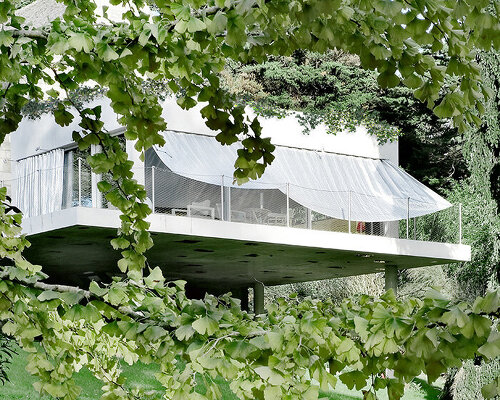poured-in-place concrete clads Mesure Studio’s house in france
Mesure Studio completes a seaside residence nestled into the steep slopes of Forêt-Fouesnant on the coast of Brittany, France, that pairs experimental low-carbon construction with strategies for thermal comfort in shifting climates. The 100 square-meter house is defined by its raw interior of exposed natural cork and an envelope of poured-in-place concrete, into which sheets of polished stainless steel are inlaid to create reflective mineral silhouettes.
Rather than replicate the pitched granite-roofed houses typical of the region, the architects developed a contemporary interpretation of the lean-to form. The roofline is lifted from the ground and detached from the gable, a gesture that protects key sightlines while generating a belvedere overlooking the pond and the Atlantic. This elevated volume also shelters a shaded garden below, designed to mitigate heat during increasingly intense summers and provide cover during periods of rain. As the landscape rises toward the house, the garden extends upward to crown the building with a green roof.
Large exterior curtains slide across the facade, filtering solar gain and accentuating the impression of the elevated volume floating lightly above the sloping ground. In this way, the house negotiates its exposure to sea winds, sunlight, and rain while sustaining visual continuity with the ocean horizon.
all images by Raphaël Boursier Desvignes
Low-carbon concrete as both structure and surface
The house’s concrete shell is treated as a crafted material, poured on-site using a low-carbon mix; its surfaces are articulated in multiple finishes — sanded, bush-hammered, smooth, and matt — so that each exposure responds to light differently. Mirror-polished stainless steel inserts embedded within the walls recall the geological origins of stone while producing fleeting reflections of the surrounding vegetation and sky. For outside use, the Paris- and Bretagne-based team at Mesure Studio chooses XS2 concrete for its resistance to saline air, eliminating the need for cladding or coatings that might weather poorly in a marine environment.
Inside, the architects leave insulation uncovered, with cork surfaces continuing the vegetal character of the shaded garden. This choice is both environmental and sensory, as cork improves acoustic absorption, regulates thermal comfort, and removes the need for secondary finishes such as linings or paint, reducing material layers and the project’s duration. The interior’s rawness contrasts with the luminous reflections cast by the embedded steel on the exterior.
Mesure Studio completes a seaside residence nestled into the steep slopes of Forêt-Fouesnant
the house pairs experimental low-carbon construction with strategies for thermal comfort
polished stainless steel are inlaid to create reflective mineral silhouettes
large exterior curtains slide across the facade
accentuating the impression of the elevated volume floating lightly above the sloping ground
this elevated volume shelters a shaded garden below
designed to mitigate heat during increasingly intense summers and provide cover during periods of rain
a contemporary interpretation of the lean-to form
the house’s concrete shell is treated as a crafted material
cork surfaces continue the vegetal character of the shaded garden
cork improves acoustic absorption, regulates thermal comfort, and removes the need for secondary finishes
project info:
name: House in Forêt-Fouesnant
architect: Mesure Studio | @mesure_studio
location: Forêt-Fouesnant, Brittany, France
area: 100 square meters
photographer: Raphaël Boursier Desvignes
The post sliding curtains veil ecological cork-clad residence by mesure studio in brittany, france appeared first on designboom | architecture & design magazine.

